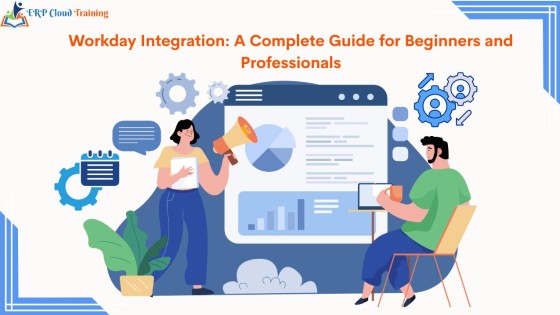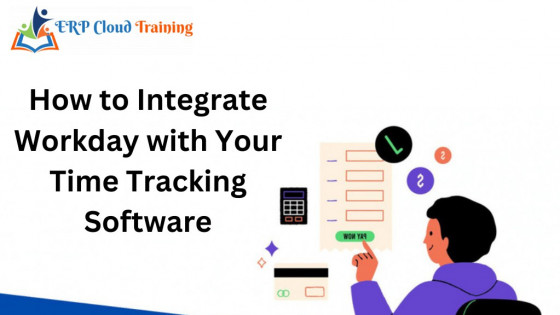Common Workday Integration Challenges and The Right Way to Handle Them

Workday Integration is an important module of the workday, here will list out the challenges that students face along with how to overcome those.
Choosing a reliable integration tool can be a tasking process. Short research would introduce you to Workday, a globally renowned tool that includes many business processes to provide an end-to-end integration solution. However, Workday Integration comes with a distinct set of challenges that businesses should be ready to tackle. ERP conducts extensive Workday Training that enables professionals to understand and take the tasks head-on with far-reaching knowledge on the subject. The training also extends to Workday Payroll Integration Training and Workday Studio Training.
Common Workday Integration Challenges
It is said that 70% of system integration projects don't go as planned. Another study shows that nearly 92% of HCM solutions of organizations underperform time and again. It applies to Workday, as they are one of the front runners in the HCM industry, especially for large-scale enterprises. We will be discussing common Workday Integration and insights on how to tackle them effectively.
1. Dynamic Requirements of a Peer-to-Peer Solution
When you consider a peer-to-peer solution for your integration to sync real-time data between Workday and other services to ensure the proper flow of business processes, you are expecting direct connections between these points. Changing this setup is where the problem arises.
When tweaks, however minor or major are on the line, it can be tasking and require expert assistance. This process might consume time cause a halt and lead to unprecedented gaps in the business flow. The less flexible medium requires in-house consultants or a reliable connection who can act quickly and ensure a smooth process.
2. Choosing between In-House and Integration Agency
Being the application that ties all the different business functions together, Workday holds consistent, iterative updates. Picking the right partner for handling and managing your Workday Integration is key to ensuring zero gaps. By assessing the resources and magnitude of the task at hand, it is essential to make the right choice between in-house members or agencies. It is said that 75% of Workday deployments are carried out by the agency or service partners.
It is essential to not go with the crowd's choice but your requirements. However, being in the right company can benefit your purpose – they should hold in-depth know-how of the entire software and stay on top of announcements made by Workday. If you are going for the in-house members, it makes sense to choose someone with proper Workday Integration Training.
3. Alignment of Integration with your Existing Processes
Every organization has its approach to business processes – from payroll, and HR to financial management. The default setting of Workday needs not necessarily align with the same. It can lead to an extra layer to customize the software setup or revamp your company procedures.
Both of the scenarios require overhead resources – cost and time. The time to go live gets extended due to multiple customization processes and testing phases to ensure you are good to go. Unless your business situation allows you to occupy the delay and surge, this can be a major hiccup in the integration process.
4. Proper Documentation to accompany Workday Integration
Workday Integration can be a complex process with multiple customizations to fit the unique requirements of an enterprise. Similar to any software practice, it is essential to back the integration process with an extensive documentation procedure. Whether you have an in-house member or an external agency, detailed documentation for installation and updates, regardless of magnitude, is key to ensuring the seamless scalability of Workday.
This often-overlooked procedure introduces transparency to the process and proper distribution of documents among stakeholders. It is also essential to allocate storage and location for the storage of documentation.
5. Extensive Testing Phase of the Integration
The testing phase of major integration procedures is often extended, complex, and required rigorous testing. The strategy should consider multiple testing scenarios set in place by a team of skilled professionals who have an in-depth understanding of the use cases from the end-user perspective.
While testing automation is an option to consider if you hold a sufficient budget in the department, leveraging a professional or agency partner with the sufficient skill set, knowledge, and experience to handle the project.
6. Updates during the Rollout
The integration process for large-scale enterprises ideally takes four to six months to complete. But knowing Workday, you can anticipate two to three updates in the said time. It means that you should re-align, jump back to the planning stage if required, and adjust your initial metrics to ensure seamless integration.
The documentation process will assist with this challenge. A careful change management plan with an elastic allocation of resources allows you to march past the challenge with ease.
7. Data Migration and Conversion
Because we are moving to a data-driven environment, it is essential to make the most out of existing data. The hiccup faced in proper migration lies in matching the existing data format to that of Workday. You might have to deal with incorrect, duplicate, non-existing entities of data.
Keeping a close eye on these points and leveraging techniques to counter these points with industry-recommended practices shall help in a seamless migration process.
While it is daunting to get Workday up and running, the solution has garnered many positive reviews and assisted businesses constructively. ERP’s Workday Integration Training can help you understand the application in and out and help with seamless integration processes that face challenges effectively.
Categories: : Workday Integration Training
Article written by
Mary is a globally recognized ERP and Workday expert, and the founder of ERP Cloud Training, with over 30 years of ERP implementation experience and 17+ years specializing in Workday. As a functional and technical subject matter expert, she was part of the original Workday design team and has led enterprise-wide deployments across 40+ modules, including HCM, Finance, Payroll, Recruiting, and Integrations, in collaboration with top-tier firms such as IBM, Accenture, PwC, KPMG, and Alight.
Mary is also a prolific Workday blog author, dedicated to sharing her decades of hands-on experience through insightful, real-world content. Her writing dives deep into critical and often-overlooked Workday topics—many of which have never been formally taught or published. By translating complex implementation lessons into practical blog content, she enables professionals and learners to gain industry-ready knowledge far beyond textbooks or theoretical guides.
Her passion for writing stems from a desire to pass on her 30+ years of wisdom to the next generation of Workday practitioners. Mary continually upskills herself with the latest Workday innovations and trends, ensuring her blogs reflect the most current, actionable insights in the field. As a featured speaker at Workday conferences, she shares implementation strategies, problem-solving techniques, and emerging best practices drawn directly from global project experience.
Through her blogs, Mary aims to empower professionals worldwide with the depth, clarity, and confidence they need to succeed in real-world Workday roles.
 ERP Cloud Training Online
ERP Cloud Training Online 




